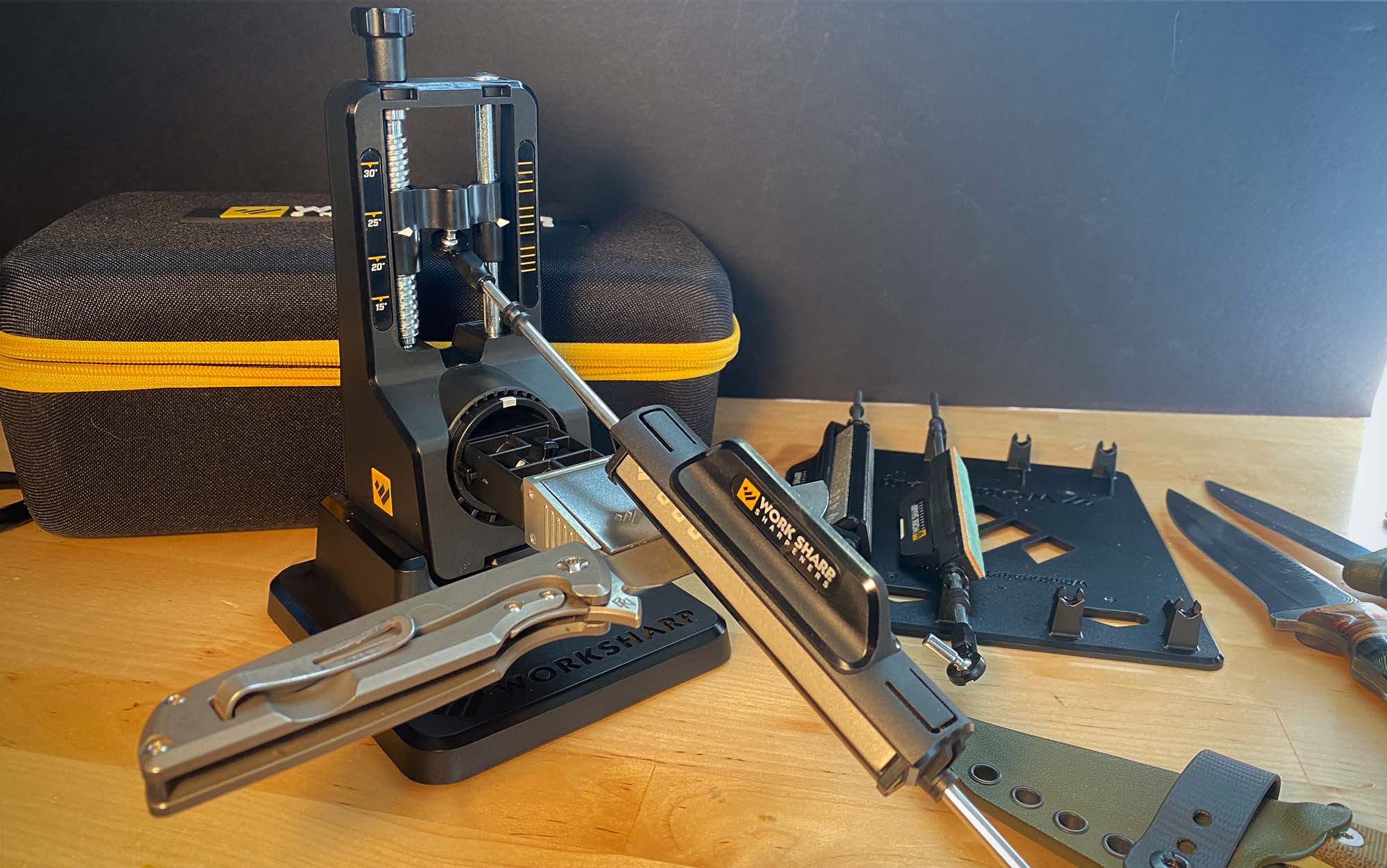We may earn revenue from the products available on this page and participate in affiliate programs. Learn More ›
I was told growing up that a dull knife was more dangerous than a sharp one. When I was a kid, it was a head-scratcher for me, but when I really started using knives on my backpacking and camping trips and to dress and butcher game, it all came into focus. A dull knife takes a lot more effort to cut and usually ends up with you ‘’sawing’’ with the knife. Consequently, you can slip off and stick yourself. The lesson is that a dull knife is a worthless knife. This is why you need a knife sharpener.
So, the cure for what ails you is a sharp knife. But no matter how good the heat treat on the blade, or how sharp the factory edge, every knife will need to be sharpened. So where to begin? Sharpeners are available anywhere from five bucks to over $500. I have been sharpening knives since I was about 14 years old, and sharpening them professionally since 2015. In that time, I have used just about everything out there and I want to help you navigate the crowded knife sharpener market. Here are my picks for the best knife sharpeners, as well as picks from Greg Campbell, a custom knife maker, and Scott Einsmann, gear editor.
Testing the Best Knife Sharpeners
We sharpened knives with varying blade angles and heat treats while evaluating the knife sharpeners on the following criteria:
- Speed
- Ease of use
- Consistency
- Edge produced
The Best Knife Sharpeners: Reviews and Recommendations
See It
Key Features
- 15 to 30 degree angle guides
- Includes: 220, 320, 400, 600, & 800 grit diamond plates, ceramic plate, leather strop, and ceramic rod for serrations
- Adjustable in 1 degree increments
- Price: $139.95
- Great for sharpening pocket knives, kitchen knives, hunting knives, and broadheads
Pros
- Precise sharpening
- Easy to use
- Versatile
Cons
Whether you need to sharpen a 2-inch pocket knife or an heirloom fixed blade, this is the best knife sharpener for the job. It can power through super steels and polish to mirror finish. I like that it’s easy to maintain a consistent edge angle and that the kit only has a few pieces. It’s also relatively inexpensive compared to similar sharpeners.
I rarely use the aggressive stones that are included in the kit, unless I’m repairing a chip. I start with the 600 grit, progress to 800 grit, and finish with the leather strop. You can go from a knife that won’t push cut paper to one that will split a hair in 10 minutes. Part of what makes sharpening go so quickly is how easy it is to rotate the stones to change grits. It’s also very easy to swap sides of the knife.
There is a learning curve to using this knife sharpener, but here are a few tips to help shorten the curve. Find the right angle by coloring the edge with a sharpie and making light passes with the stone until you find the angle where the stone removes the sharpie from the edge. Another option is to choose an angle you like and use the coarse stones to adjust your knives to that angle. Once you have an angle, the key is to use light, consistent pressure and long strokes. Remember to move the strop in one direction so that it doesn’t cut the leather. -S.E.
Best Electric: Work Sharp Ken Onion Mk 2
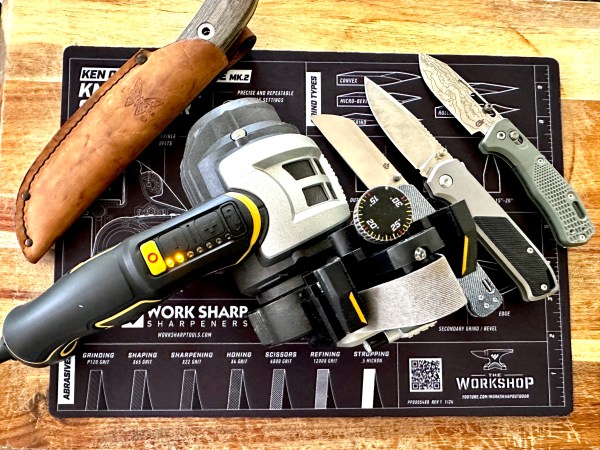
See It
Key Features
- 7-speed motor with LED display
- Adjustable sharpening guide
- Sharpens from: 15 to 30 degrees
- Tool sharpening adapter with 65-degree scissor guide
- Includes belts that range from extra coarse to extra fine
- Price: $200 (Blade Grinder is an additional $99)
Pros
- Quickly sharpens knives and tools
- Great for repairing chipped blades
- Excellent instructions included
- Versatile
Cons
- Can ruin a knife if you’re not careful
- Noisy
The Work Sharp Ken Onion sharpener has been our best electric knife sharpener pick for three years running because it’s versatile, fast, and easy to use. Sharpening is a skill, and you can go down the deep rabbit hole of whetstones or expensive fixed-angle systems. But most people want to sharpen their knives quickly and get on with their day. They also don’t want multiple sharpeners for kitchen knives, pocket knives, scissors, and garden tools. That’s the role the Work Sharp fills, and it does it exceptionally well.

Photo by Scott Einsmann
How it Works
This knife sharpener uses abrasive belts, rather than stones, of different grits. A small motor spins the belt, and using the angle guides, you pull the knife across the belt to remove material. Work Sharp includes detailed instructions in the box, and they have a bunch of helpful YouTube videos. I recommend learning to use the sharpener with an inexpensive knife because if you’re using a course belt at high speeds, you can quickly remove a lot of material and ruin a knife.
Testing
In testing the new Mk 2, I sharpened knives that went through my rigorous EDC knife test, hunting knives, and kitchen knives. The addition of the Blade Grinder attachment allowed me to try my hand at freehand sharpening knives, and I used it to sharpen much-neglected scissors and pruners.
The Mk 2 is just as easy to use as previous models, and it has some nice refinements. The speed control is no longer a nob, but plus and minus buttons with lighted level indicators. There’s also a constant-on function, which frees up both hands for sharpening. The angle adjustment is done on a smooth wheel with clicks for each degree.
If you want to take a knife from dull to sharp, a few passes with the medium belt is all that’s needed. The process only takes a few minutes. Progressing to finer belts results in a polished cutting edge that glides through material. But before you can enjoy that ease of sharpening you’ll have to reprofile your knife’s edge to the convex grind created by the belt sharpener. This process takes about 10 minutes, but once it’s done, maintenance is easy.
Easiest Kitchen Knife Sharpener: Tumbler Knife Sharpener
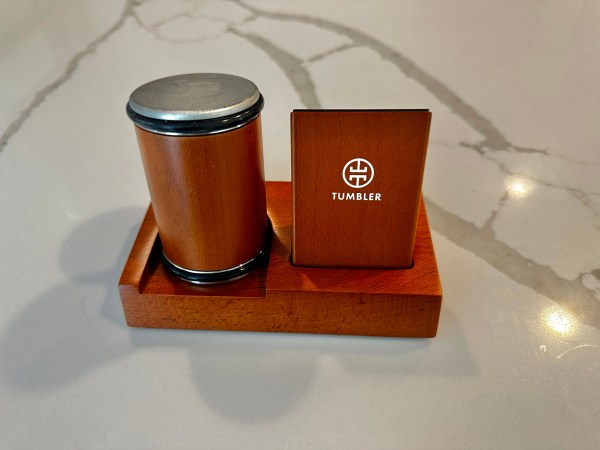
See It
Key Features
- Sharpens at 15 or 20 degree angles
- Coarse and fine sides
- Magnetic
- Price: $130
Pros
- Fast and easy to use
- No skill or technique required
Cons
- Not ideal for pocket knives
- Won’t repair large chips
All you need to use the Tumbler is a flat surface, a dull knife, and 3 minutes of your time. It’s by far the easiest kitchen knife sharpener I’ve used, and it takes no practice to get the hang of.
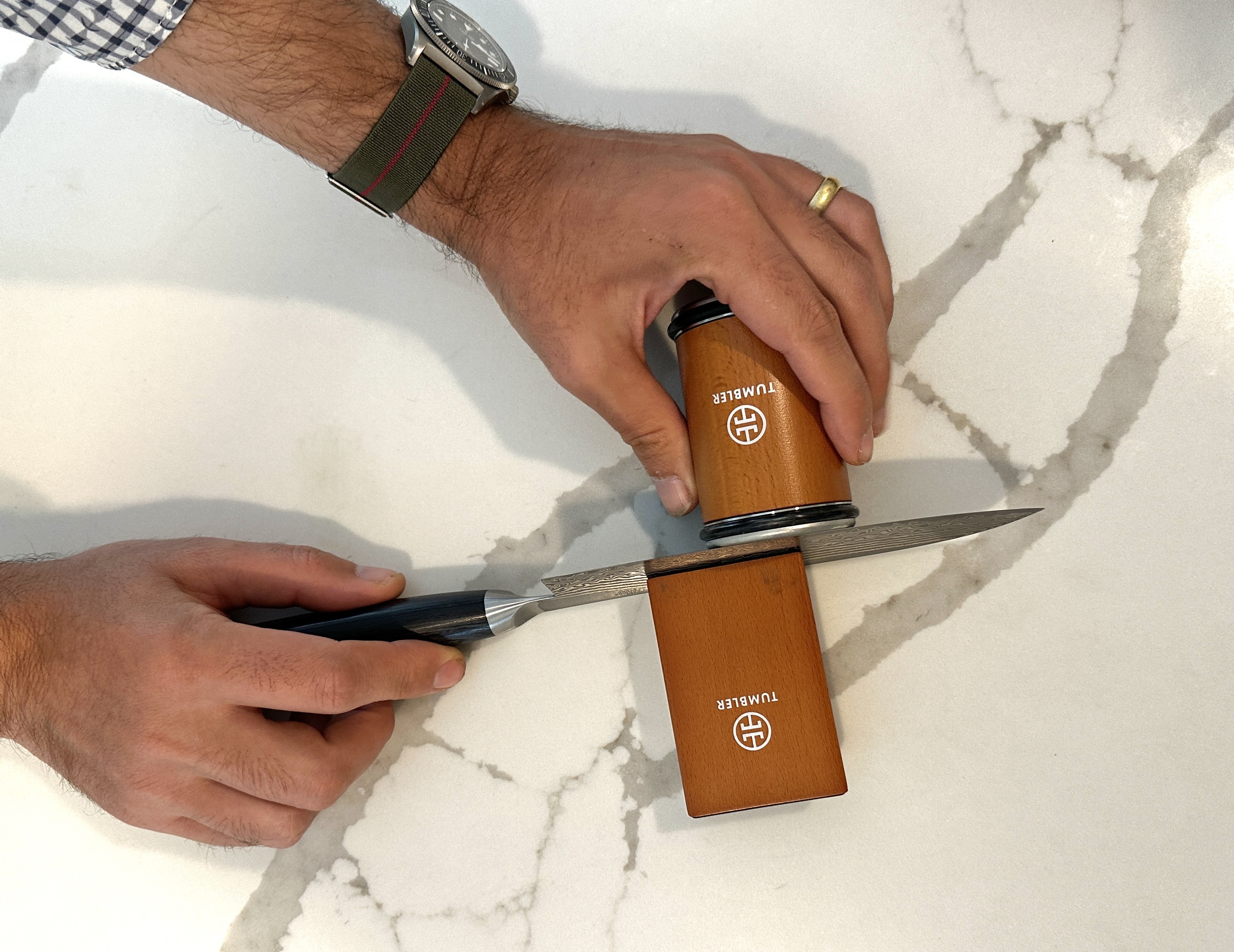
Photo by Scott Einsmann
I had a dull knife in the drawer that was aching to be brought back to life. I stuck it to the magnetic angle guide and rolled the diamond abrasive back and forth. A burr developed, and I flipped the knife over and rolled some more. The burr disappeared, and I repeated the process with the honing side. Just like that, I had a sharp kitchen knife.
This sharpener won’t work for your pocket knife and it won’t sharpen a big chip out of a blade. But you won’t find an easier or faster option for day to day kitchen knife sharpening.
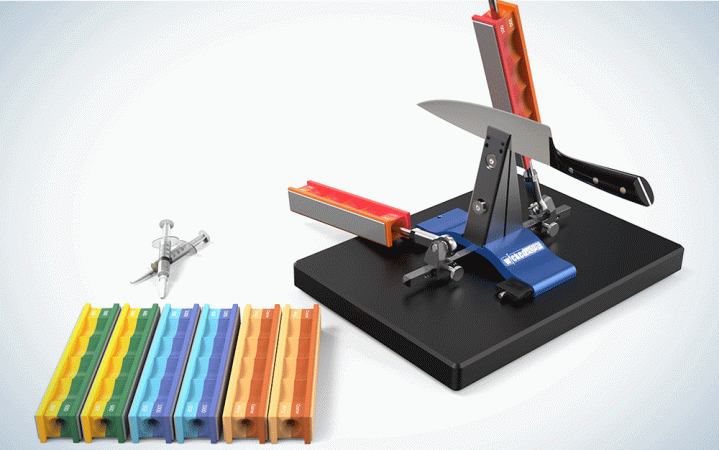
Check Latest Price
Key Features
- 12 to 28-degree angle
- Includes: 100, 200, 400, 600, 800, and 1000 grit diamond stones
- Adjustable in .5 degree increments
- Sharpens blades up to 15 inches long
- Price: $1000+
Pros
- Precise sharpening
- Easy to use
- Versatile
Cons
No, it’s not cheap, but you can’t argue with the results. I bought a Pro Pack 1 for my sharpening business, and it was worth every penny. The evolution of that system is the Gen 4 sharpener. Perfectly mirror polished, hair whittling edges every time. I have sharpened nearly 2000 high-end EDC knives with mine, and it’s still going strong. Pick any angle from 12 to 28 degrees per side, clamp it in, follow the directions, and you’re going to get a level of sharpness that you’ve probably never experienced. The Wicked Edge gives the perfect v-edge, every time. If you plan to sharpen a lot of knives, or you want the mirror edge with the least effort, this is the way to go.
Read Next: How to Sharpen a Pocket Knife
See It
Key Features
- Price: $189
- Coarse and fine sharpening stones
- Magnetic knife holder
- 15 or 20 degree angle
Pros
- Very easy to use
- No sharpening experience necessary
Cons
- Not recommended for pocket knives

If you don’t want to spend months practicing how to sharpen a knife, this is the ultimate sharpening system for your kitchen knives. All you have to do is stick the knife to the magnetic angle guide, and then roll the sharpening stone back and fourth until you see a bur develop. Then flip the knife over and repeat on the other side. It takes minutes and there is no technique mastery necessary.
Check Latest Price
Key Features
- Length: 4.75 inches
- Width: 1.25 inches
- Comes with carrying case
- Price: $14.50
Pros
- Precise sharpening
- Easy to use
- Versatile
Cons
I cut my teeth on a Smith’s Medium Arkansas Stone. And for the price, you can’t beat them. There are some “pull-through” sharpeners out there for a little less than the cost of a knife-sharpening stone, but they really don’t do a good job, and they chew up your blade. The small 4 inch stone can be had for around $10, but the 6-inch stone is preferable for a little more money. This blade sharpener method will take some practice, and you might not get the results you want right off the bat, but when you master it, there is a deep satisfaction that comes from it. Learning to keep your angle consistent will be the biggest hurdle, but there are many good tutorials online, and Smith’s does make small guides to help you out in the beginning. Depending on your technique, you can either get a v-edge, or a slight convex from a stone. A very slight “rocking” motion at the end of each pass can produce a convex if you prefer.
Best for Kitchen Knives: Spyderco Tri-Angle Sharpmaker
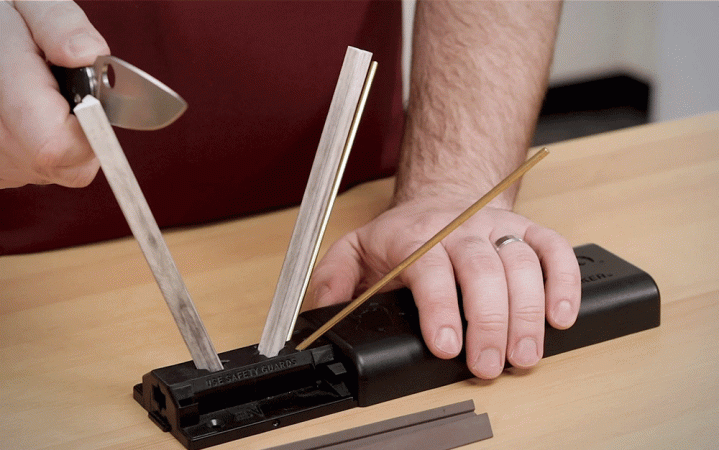
Check Latest Price
Key Features
- Ceramic Stones: Medium (brown) and fine (white)
- Can be set to 30° (15° each side) or 40° (20° each side)
- Aluminum safety rods
- Can sharpen knives, scissors, and awls
- Price: $89
Pros
- Precise sharpening
- Easy to use
- Versatile
Cons
Kitchen knives usually aren’t taking big hits, and really need more maintenance than anything. The Sharpmaker is perfect for maintenance. It comes with ceramic rods of differing grits, depending on how much material you need to remove. It’s also a semi-guided system and lets you choose from some preset angles. You hold the knife nice and straight and make alternating passes down each ceramic rod with a sweeping motion to get it sharp from the heel all the way to the tip. Again, it will take some practice, but this sharpener gives excellent results, and can bring you edge to a near mirror polish with practice. If your edge has some real damage, it may take some time to sharpen it out. The Sharpmaker doesn’t have a coarse enough rod to remove damage quickly. It’s worth noting that this system will work with blades of any size. You can put a nice v-edge on anything from a Case Mini-Trapper to a meat carving knife.
Best Whetstone: Keenbest Sharpening Stone
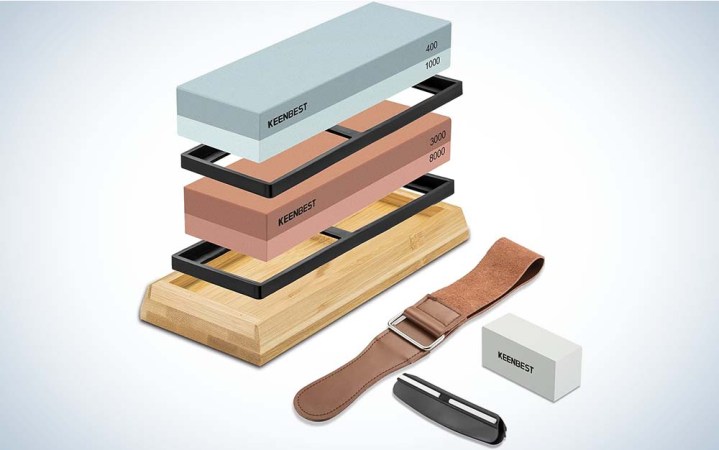
See It
Key Features
- Two double-sides stones
- Silicon carbide construction
- 7”x2.2”x1” sized stones
Pros
- Sturdy and simple design
- Inexpensive cost
- Contains all you need to effectively sharpen your knives in one kit
Cons
- It comes with a set angle guide that may not work for every style of knife you sharpen
- At 7 pounds, it’s a little heavy for travel
The Keenbest Sharpening Stone is an inexpensive, easy-to-use set that comes with two whetstones, one with 400/1000 grit and the other with 3000/8000 grit. The heavy duty base is made of bamboo, with rubber on the bottom to keep it in place when sharpening — a convenience and a safety feature. The whetstones are two different colors, a light green and a light orange, allowing the user to quickly identify the proper stone. It also comes with a “resurfacer,” otherwise known as a flattening stone that is used to flatten the whetstones as they get worn away with use. Keenbest includes a leather strop and an angle guide — everything you need to sharpen and maintain your blades is included. Keenbest includes a helpful list of tips for using this system. There are more expensive stones on the market, but these stones are highly effective, and with a little patience and work, are great for getting that sharp cutting edge you’re looking for. -Greg Campbell
See It
Key Features
- Rough and smooth side
- 12.5 inches long
- 2.17 inches wide
- Includes four grits of stropping compound
Pros
- Plenty of surface area
- High-quality leather
Cons
- Some users might prefer two smooth leather sides
I use this strop daily for my leather working tools and for touching up my pocket knife between sharpenings. I keep a medium stropping compound on one side and a fine compound on the other. With this strop and the included stropping compound you can take an edge that’s sharp and bring it back to very sharp in just a few swipes. If you keep your tools sharp and never let them get dull, you won’t have to use a stone unless you do some damage. That’s why a strop is a must have-tool for maintaining your blades. -S.E.
See It
Key Features
- 2000/3000 Grit
- 11.5 inches long
- Ceramic
Pros
- Great for kitchen knives
- Easy to use
Cons
Open my kitchen knife drawer and you’ll find this ceramic hone. I bought it after a friend of mine, who is a custom knife maker, recommended it. I use it to touch up my chef’s knife before every use and instead of sharpening weekly, I’m down to sharpening my kitchen knives monthly. Just like a strop, the key is maintenance. Keep your knives sharp, and you won’t have to sharpen them. When it comes to honing rods the most common mistake is using them the wrong way. If you are holding the hone in one hand as you quickly swipe the blade in the other, you’re doing it wrong.

The right way to use it is to put the tip of the hone on your cutting board, then while maintaining a consistent angle make even passes on each side of the blade. S.E.
Best for Your Pack: Work Sharp Pivot
See It
Key Features
- 25 degree carbide sharpening blades
- 320 grit diamond sharpening surface
- Fine-grit ceramic rods
- Weight: 2.4 ounces
Pros
Cons
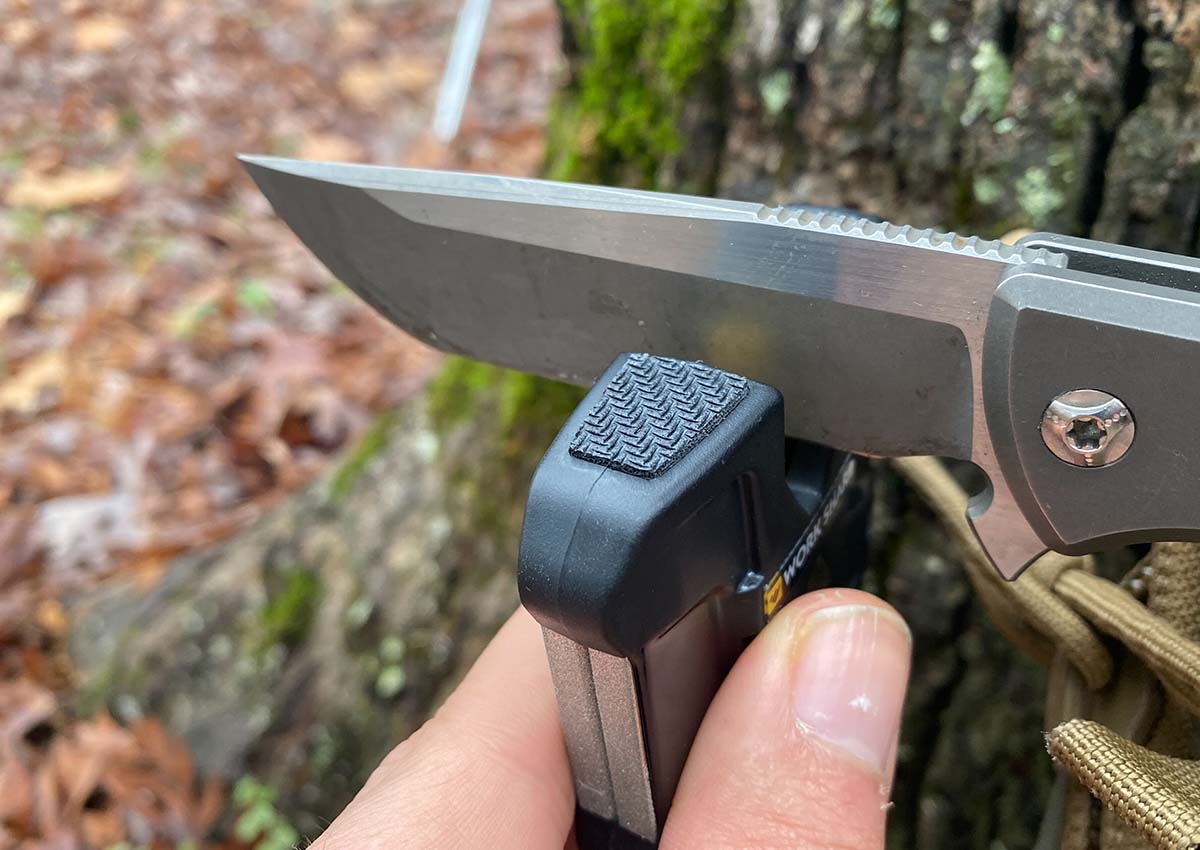
When your hunting knife gets dull while you’re boning out an elk, you need a sharpener that will quickly get you back to work. That’s where the Wicked Edge Pivot excels. It’s not a fancy sharpener and it’s not going to produce mirror edges, but when your knife is dull, it will make it sharp. At 2.4 ounces this palm-sized sharpener isn’t too big to keep in your pack. Since my hunting knife of choice is now a fixed blade, the Pivot has a permanent place in my kill kit. One of the keys to using this sharpener is to not press down on the blade, just use the weight of the knife for downward pressure as you pull the knife across the rods. -S.E.
Read Next: How to Sharpen a Knife
How to Choose the Best Knife Sharpener
My dad was a sushi chef and he started everyday by soaking his whetstones and bringing his knives to a fine edge. His stones are still being used to sharpen my kitchen knives and they’ll last for many years to come.
But they’re not the best knife sharpener for every job. On my knives made from high-rockwell stainless steels, I prefer an electric sharpener to repair chips and diamond stones for general maintenance. And sometimes, getting the whetstones prepped is a pain. So I’ll reach for a honing rod to quickly get a blade ready to cut, sorry dad.
Types of Knife Sharpeners
You can make a dull knife sharp with a car window or a thousand dollar sharpening stone. We’ve reviewed a lot of options between those two options and the trick is going to be determining which is best for you. Here are some pros and cons to consider for the three main types of sharpeners.
Electric Knife Sharpeners
Pros
- Sharpen knives quickly
- Easy to use
- Great for repairing chips
- Produce a convex edge
Cons
- Can ruin a knife quickly
- The convex edge isn’t ideal for all cutting applications
Guided Knife Sharpeners
Pros
- Easy to use
- Sharpen most knives
Cons
- Takes time to setup and use
Stones
Pros
- The ultimate sharpening flex
- Can produce a toothy or fine edge
- Don’t remove too much steel
Cons
Honing a Knife versus Sharpening a Knife
A knife sharpener removes metal from a knife to create a new cutting edge. A honing rod refines an already sharp edge. Think of a honing rod or pull-through sharpener as maintenance tools for keeping your knife sharp. Even with consistent honing, your knife will eventually need sharpening by a stone or belt sharpener.
Type of Edge
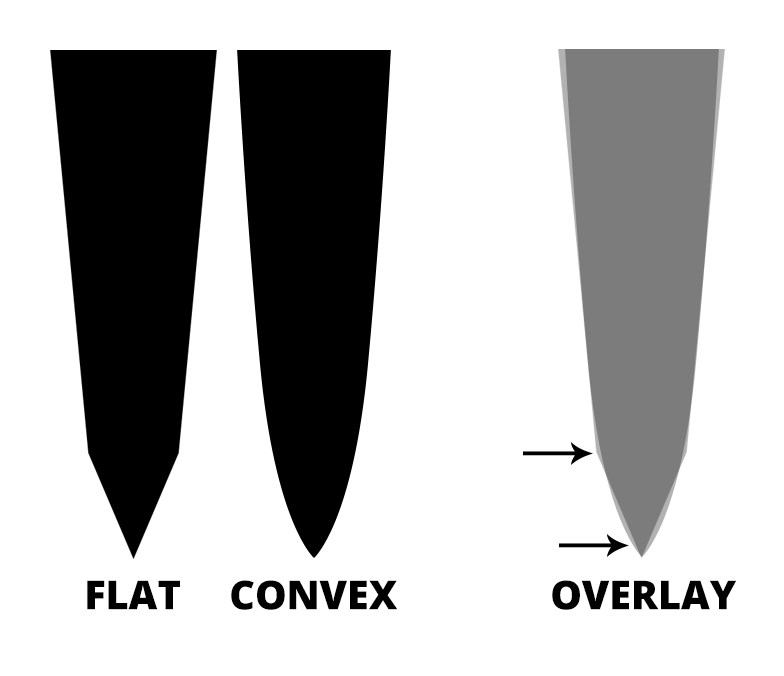
There are two primary types of edges a sharpener can put on a knife, a v-edge and a convex edge. The v-edge has a cross-section that looks like a “V.” A convex edge has a slight curve to the bevel, like a “V” that curves inward slightly at the bottom. A convex edge is generally more durable, and less likely to chip or roll under heavy use, but they usually don’t feel as sharp as a v-edge of the same angle. Both types of edges can be made sharp enough to whittle hair, and both are great in the right application.
The last factor you should look at before choosing a sharpener is edge angle. To keep it simple, the smaller, more acute the angle, the sharper the knife will be, and the better the outright cutting performance. But, that performance comes at the cost of edge strength and stability. The lower your angle, the more likely you are to chip or roll your edge if you run into something hard like bone, or a staple in the cardboard, or a bullet fragment in your game meat. Many systems have angle guides that help you maintain a consistent angle across the entire edge, and they let you pick from a range of angles.
FAQs
Pull through sharpeners can do more harm than good. Some models are fine for light touch-ups, but they don’t really sharpen a knife. It’s much better to invest in a ceramic hone and learn how to use it properly.
The best way to sharpen a kitchen knife is to use a ceramic hone for touch-ups and a guided sharpening system like the Work Sharp Ken Onion knife sharpener.
Knife sharpeners work extremely well if you take the time to learn how to use them. The good news is best knife sharpeners in this review are all easy to use.
Final Thoughts on the Best Knife Sharpeners
Few things match the satisfaction of taking a rough edge to a polished edge that will split hairs. Whether you choose a manual knife sharpener like the Wicked Edge or an electric sharpener like the Work Sharp, you can produce a sharp knife that will give you the satisfaction of slicing paper with ease.
Read the full article here

